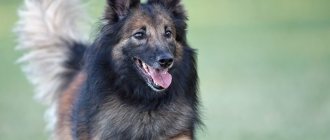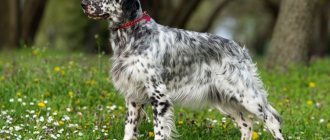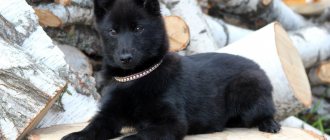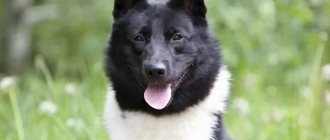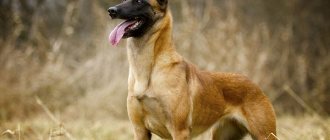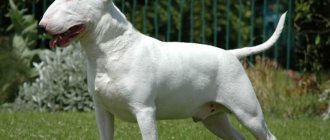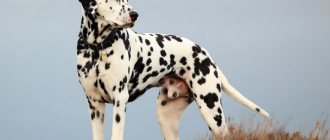A barking dog can be a real nuisance, especially if you live close to neighbors. You can train your dog to bark less, but you can also choose a breed with a low tendency to bark. For example, some breeds were bred to be "barking" hunting dogs to warn of prey. And other dogs are silent and remain unnoticed, this helps them quietly sneak up and catch the game.
Breeds that bark less are more confident, have a daily routine, and are comfortable with their family.
Dogs that are prone to barking may be experiencing separation anxiety, various phobias, or simply seeking attention. They may bark out of excitement, anxiety or boredom. This is their natural way of communicating, and owners must understand the reasons for barking before they can address their pet's behavior.
If your dog barks, you face a fine. How to avoid it?
Here are 15 generally quiet dog breeds that make great companions, especially if your neighbors are noise sensitive.
AFGHAN HOUND
Photo: Glow Images, Inc/Getty Images
Afghan Hounds are generally quiet and independent, playful and affectionate with their loved ones. They are very loyal to their families. These rather energetic and slightly stubborn dogs are not suitable for every home, and their silky coat requires special, careful care.
MORE DETAILS
Maintenance and care
The ideal place to keep it would be a country house with a large yard, but nothing prevents you from getting a Basenji in the city, provided that the owner is not lazy to walk with her at least twice a day for an hour.
With a lack of physical activity, pets have a destructive effect on the apartment: they tear up wallpaper, chew furniture, and like to chew the owner’s things and shoes. This can be avoided by providing your dog with an adequate level of physical activity. It will be great if the owner has the opportunity to indulge his hunting instincts.
The Basenji is clean ; many owners say that they have caught their dogs washing themselves with their paws, like cats. No grooming required.
Breeders recommend feeding dogs already balanced dry food or dry food in combination with wet food in a 3:1 ratio.
AKITA INU
- Dog breeds / large / for protection / for apartments / guard / do not bark
Photo: Sandra Schmid/Getty Images
Akitas make excellent guard dogs and usually bark only to warn of danger. They are very loyal and often form strong bonds with just a few people, and stay aloof from strangers. Constant training is a must as Akitas are a bit stubborn.
MORE DETAILS
Add to cart
Quick view
Compare
Close
BOZITA X-LARGE dry food for adult dogs of large breeds with normal activity
5 200,00 ₽
Shar Pei
Due to the peculiarities of the Shar Pei's skin, namely the folds, the dogs are popular in many countries around the world. Shar Peis are distinguished by courage, strength, excellent watchdog and security qualities, self-confidence and devotion to their owners.
And if a voice is needed, it will be used if necessary to warn the owner about something important.
The dog has a sharp mind, intelligence, and goodwill towards children. We cannot neglect the fact that the Shar Pei is initially aggressive by nature, so its early socialization, demanding training (without rudeness and violence) is required and the pet will develop its best qualities.
Shar Pei height is 45-50 centimeters, weight varies from 18 to 25 kilograms, life expectancy is 9-10 years.
Shar Pei requires active long walks: the more energy he splashes out on the street, the calmer he will behave at home.
BASENJI
- Dog breeds / small / smart / guard / don't bark
Photo: Tara Gregg/Getty Images
Basenjis don't bark. Instead, the dog howls or even sings, which is very similar to “yodeling.” They are not particularly noisy, but when excited, these energetic dogs will occasionally yelp, whine or "sing out Tyrolean tunes."
MORE DETAILS
Bulldog
Looking at squat dogs with a fairly strong physique, one can assume that they are active, energetic, noisy, and bark often and loudly. But this is a misleading impression. Bulldogs have a calm, peaceful and kind disposition. Perhaps due to this nature or the peculiarities of the physical constitution, representatives of the breed rarely bark and almost never make sharp, loud sounds.
It has become clear whether weather affects the transmission of coronavirus
A banal “don’t worry” is unlikely to calm a person: what can replace it?
Russians can be rewarded financially if they restore forests
CHOW-CHOW
- Dog breeds/medium/for apartments/guard/do not bark
Photo: mimilasouris7/Getty Images
The Chow Chow is a resilient and independent dog breed known for its bear-like appearance and bluish-black tongue. Chows usually do not bark unless they sense danger. Even so, they are not particularly noisy. They are sometimes aggressive, but mostly because they want to protect themselves or their family.
MORE DETAILS
How to teach a dog not to make noise in the home office? Catch this life hack!
Dog breeds that don't bark
Silent dogs, who are not prone to frequent barking, are often chosen as pets, but it is worth understanding that this is not the only feature of such animals; there may be more significant nuances in their upbringing and maintenance.
Basenji
The Basenji, Congo Terrier or African non-barking dog is one of the most famous breeds that does not bark like dogs are used to. Due to the special structure of the larynx, such pets rumble, and upon reaching puberty they can sing in the Tyrolean manner. Basenjis are medium-sized dogs, with a height at the withers of 40–43 cm and a weight of 9–11 kg. Representatives have short hair, which can be of 4 types of color:
- red and white;
- black and white;
- tricolor;
- brindle with black stripes on a red background.
Congo Terriers have good health and quickly get used to their owner. They are obedient and very clean, requiring minimal care. At the same time, the breed is small in number, so puppies are expensive, starting from $1,000.
The Basenji is known as the only breed that cannot bark for physiological reasons.
Bullmastiff
Bullmastiffs are a breed created by crossing an English Mastiff and an Old English Bulldog. This is a large and muscular animal, weighing 40–60 kg with a height at the withers of 61 to 68 cm. Representatives can bark and have a deep bass voice, but they do this extremely rarely due to their calm and reserved character. The breed was bred to protect forest lands from poachers, therefore, in case of a threat, the animal will prefer to growl and only call its owner once if necessary, but it will not bark just like that.
Bullmastiffs have a very reserved character, so they rarely bark.
Bullmastiffs have short hair that can be red, brindle or fawn. Raising and training usually does not cause any difficulties - these are wayward, but loyal and intelligent pets. The only problem with care can be the large size of the dog - it needs space and regular physical activity. A bullmastiff puppy today costs from 40 thousand rubles.
Russian greyhound
Russian greyhounds are hunting dogs with an elegant appearance and a very reserved character. That is why you should not expect unreasonable or frequent barking from such a dog; the pet will use its voice only when necessary. These are tall dogs (from 68 to 86 cm), but very dry, so their weight ranges from 25–45 kg. They have a long and narrow snout, small ears and a long thin tail.
The coat of Russian Greyhounds is long, soft and wavy, and the color can be anything from white to dappled (red or gray with dark stripes). In training you will have to deal with stubbornness - these dogs were bred to make independent decisions when hunting, so it is not easy to train them. There are no difficulties in keeping a pet at home; it is only important to provide the animal with a lot of physical activity. The price of a puppy starts from 25 thousand rubles and can reach up to a thousand dollars.
Russian Greyhounds have a typical hunting dog build - they are tall and slender.
Saluki
Saluki (Persian greyhound, gazelle dog) is an elegant and large animal (up to 71 cm at the withers), designed for hunting small game and gazelles. These dogs are balanced and extremely silent; they can chase prey for several hours in complete silence. Representatives of the breed are very affectionate, treat children well, and therefore make excellent pets. Salukis have two types of coat: smooth and feathered, that is, with long hair on the ears, tail and back of the legs. The standard allows all colors, and only one is considered undesirable - brindle.
The Saluki is an elegant and extremely silent breed of dog.
The slender Persian Greyhound, like all hunting breeds, requires daily physical activity (active running), and also has the ability to make independent decisions, which often interferes with training. As for the cost, you can buy a purebred puppy for $400–800.
Deerhound
The Deerhound is a hunting breed designed for deer hunting. These dogs can bark, and loudly enough to notify the owner of their prey, but due to the nature of their use, they will not make any extra noise. Deerhounds are silent in life; they even hunt exclusively using their sense of smell and sight, without barking or human participation. They are characterized by a typical greyhound appearance: graceful body, long limbs. Height at the withers is 72–75 cm depending on gender, weight is 35–45 kg. The cost of a puppy is from 200 dollars.
The coat of the Scottish greyhound is long, consisting of hard and dense hairs. Visually, the dog appears unkempt, with disheveled and matted fur. The color is predominantly gray, but there are also dogs of sand, brown, brindle and fawn colors. Deerhounds are affectionate and even-tempered dogs and are unconditionally loyal to their owner. They do not take up much space in the house, do not get in the way, and do not spoil things, which makes them excellent pets. But representatives of the breed do not tolerate direct sunlight well, so walks should only be in shaded areas.
Deerhounds have a rough coat that makes them look a little unkempt.
Afghan Hound
The Afghan Hound is a hunting breed that has a striking appearance. Representatives have long silky hair, which can be of any color and requires constant care: washing, combing, trimming. The body type is typical for hunters: they are tall (65–70 cm at the withers), slender (23–30 kg), with a narrow and elongated muzzle. The Afghan Hound's ears are covered with even longer hair that hangs down the sides of the head.
By nature, these are calm and determined dogs. They have a low propensity to bark, using it mainly only for working purposes when hunting. Their peculiarity is independence and unsociability; they have a low need for attention from humans. Because of this, they are difficult to train. The breed is not very widespread, so puppies are quite expensive (from $800).
Afghan Hounds require regular grooming.
German dog
Large Great Danes can reach a height of 71–86 cm and weigh from 45 to 90 kg. These are cautious and intelligent dogs that are easy to train and train. Despite their intimidating appearance, they are very affectionate and loving family members. Calm pets are completely silent - they will bark only on command or if they need to attract the owner's attention. You will have to pay a lot of money for a Great Dane - from 800 to 2000 dollars.
Great Danes are large but very affectionate dogs.
Caring for representatives of the breed is simple, they have short hair (it can be black, blue and brown), and they do not require much physical activity. But the Great Dane will take up a lot of space due to its size. In addition, the size of the dog increases the risk of developing a number of diseases: joint dysplasia, gastric volvulus, heart disease, etc.
Clumber Spaniel
Clumber is the largest representative of spaniels (height at the withers up to 50 cm, weight up to 30 kg), which is distinguished by its phlegmatic nature and slowness. It is precisely these character traits that determine his restraint - a dog of this breed barks extremely rarely, preferring to grumble displeasedly.
The Clumber Spaniel is the largest representative of spaniels, characterized by a phlegmatic character.
Clumber Spaniels have a voluminous head with a sleepy muzzle expression and a close-fitting, straight and silky coat of medium length. The color in most cases is lemon or orange, but pure white is also acceptable. There are no particular difficulties in caring for it; it is important for the owner to pay attention to the condition of the floppy ears, checking them daily after a walk, as well as on the eyelids (volvulus is possible). The average price for a purebred puppy is $500.
There are no breeds of dogs that cannot make any sounds at all. There are dogs that do not bark due to the structure of their pharynx, but instead produce sounds of a different type, and there are those that, due to their temperament and upbringing, are simply silent and bark extremely rarely.
BORDER COLLIE
Dog breeds / for children / herding / medium / smart / do not bark
Photo: gentledogtrainers.com.au
Intelligent and athletic, Border Collies tend to remain silent until they feel it is necessary to communicate something important. Caring for their coat is necessary: it needs to be brushed several times a week. Exercise needs are also quite high, but training is usually not difficult.
Add to cart
Quick view
Compare
Close
Monge Dog Fresh Chunks in Loaf canned food for dogs duck meatloaf
150,00 ₽
Add to cart
Quick view
Compare
Close
Monge Dog Fresh Chunks in Loaf canned food for dogs meatloaf veal
150,00 ₽
MORE DETAILS
Breed care
Basenji needs clothes. Therefore, for the winter, he needs overalls for walks in the fresh air. They are protected from cold and drafts. At the same time, high summer temperatures are tolerated perfectly, without interfering with walks and fun even in the midday heat.
Attention! Nyam Nyam Terriers are afraid of water. Therefore, it is forbidden to force them to swim. According to one version, the phobia is genetically based due to the fear of crocodiles.
Due to water intolerance, swimming is also contraindicated. The fur should be brushed periodically. If necessary, wipe the body with wet wipes. They also perform standard hygiene procedures for caring for the oral cavity and ears.
Basenjis need to have their coat brushed periodically.
Walks
Ensure sufficient physical activity. It is good to find an area where free walking is possible, without a leash, so that the pet can splash out its energy. A great option is to take your dog with you while jogging, traveling through the forest, or hiking. Hours of walking do not tire the animal at all. When given enough exercise, Basenjis are sweet and quiet at home.
GREYHOUND
- Dog breeds / large / hunting / fast / do not bark
Photo: The Spruce/Kevin Norris
Greyhounds are one of the few dog breeds that can be called quiet. They require a moderate amount of exercise. Some of them develop very close bonds with their family and express their resentment when they are left alone. Behavioral training can fix this.
MORE DETAILS
Who's that barking at home?
Results
Basically, people do not know about dogs that have a complete lack of barking ability or simply do not use it. In addition to the above breeds, there is a whole list of dogs that, due to their character and nature, do not bark without a particular reason.
Such dogs can bark only in emergency, dangerous situations, when it is necessary to defend the family, or to attract the attention of the owner.
When bringing a dog, especially into an apartment, take into account such factors as barking, as a quiet dog will become a more pleasant neighbor for you.
NEWFOUNDLAND
- Dog breeds / for children / large / for protection / guard / do not bark
Photo: Alexandra Draghici/Getty Images
The Newfoundland is an affectionate dog that is extremely loyal to its people. Barking is not typical unless the dog needs to alert you to something. They need a lot of exercise, but not as much care as they seem. Most of them are highly trainable.
MORE DETAILS
ST BERNARD
- Dog breeds / for children / large / for protection / guard / do not bark
Photo: Purple Collar Pet Photography/Getty Images
Saint Bernards are usually silent unless they feel they need to warn you of danger. In general, these are very loyal and affectionate dogs that strive to please their owner. You need to spend time training this breed, because with such a large size, they need to be controlled.
Add to cart
Quick view
Compare
Close
Mnyams canned food for dogs Terrine a la Versailles (veal with ham)
Rating 5 out of 5
150,00 ₽
MORE DETAILS
Breed characteristics
Basenjis attract people with their aristocratic appearance, lack of bark and smell. The breed was formed in a natural environment, and humans did not take part in this process. The way of life and living conditions gave the animal smooth, long muscles that provide freedom of movement and excellent coordination. Representatives of the breed have lively facial expressions due to wrinkles between the ears.
Table 1. Basenji standard
| Criterion | Description |
| Scull | Flat, refined, narrow cheekbones |
| Bite | Full, scissor-shaped, with vertical teeth |
| Eyes | Dark, almond-shaped, slightly slanted, giving the muzzle a sly expression |
| Ears | Small in size, erect, without kinks, with a slight forward inclination. When the ears are folded, wrinkles form on the forehead |
| Neck | Strong, long |
| Frame | The back is straight, the chest is oval, the ribs are protruding, the stomach is tucked, the lumbar is short |
| Tail | Tightly coiled, ring-shaped, high and adjacent to the sacrum |
| Legs | Strong, muscular, with closed toes, rounded paws |
| Coat | Short, fine and soft coat that lies close to the skin |
| Height Weight | Male - 43 cm/11 kg, female - 40 cm/9.5 kg |
Basenji color
The FCI recognizes four types of Congo Terrier colors:
- red and white;
- bright black and white;
- deep black with red-red tan, white “melon seed” shade, spots above the eye sockets, on the muzzle and cheekbones (tricolor);
- red with black stripes; brighter combinations (brindle) are considered winning.
Basenji color options
Since we are talking about a native breed, the palette is not limited to the options described above. The following types of colors are found in nature:
- saddle cloth with black mask;
- pale yellow;
- blue.
On a note! A common feature for all variations is white spotting on the toes and tip of the tail. However, the main color should occupy a larger area of the body than white.
SHIBA INU
- Dog breeds / for guarding / medium / for apartments / guard / do not bark
Photo: Onay Jakobov/Getty Images
The Shiba Inu is a generally quiet dog that may seem reserved at first, especially around strangers. These dogs are independent but devoted to their family. They require minimal grooming and have average exercise needs.
MORE DETAILS
WHIPPET
- Dog breeds / medium / hunting / fast / do not bark
Photo: Nicole Hammond/Getty Images
Whippets are generally quiet dogs and are playful and affectionate with their family. Physical exercise is necessary, the load is from moderate to high. And since whippets can be stubborn and easily distracted, training must be consistent.
MORE DETAILS
Cavalier King Charles Spaniel - a small dog with an interesting destiny
Bullmastiff
Despite its large size and sometimes rather menacing appearance, the bullmastiff, like Hagrid from Harry Potter, surprises with its good nature and peaceful character. These dogs rarely vocalize and almost never bark, sometimes preferring to snore and grumble if they still need to “talk” with their owner.
Bullmastiffs do an excellent job of guarding and are very obedient and peaceful. They are able to live even in a small city apartment and do not require any special or tedious personal care. Although they take up quite a lot of space, because the dog weighs neither more nor less - from 40 to 60 kg, and their height reaches from 60 to 69 cm.
CAVALIER KING CHARLES SPANIEL
- Dog breeds / small / for apartments / do not bark
Photo: Bigandt_Photography/Getty Images
Cavalier King Charles Spaniels are not known to bark. But this happens if the dog craves attention or feels neglected. The Cavalier King Charles Spaniel may bark due to anxiety, fear, loneliness or separation anxiety.
MORE DETAILS
Add to cart
Quick view
Compare
Close
CeramikArt ceramic box for storing dog treats white
450,00 ₽
Add to cart
Quick view
Compare
Close
Ceram bowls in der Trixie black
2 850,00 ₽
SHARPEI
- Dog breeds / medium / smart / for apartments / guard / do not bark
Photo: zokov/Getty Images
Shar Peis bark very rarely. This is an ideal choice if you prefer a calm breed. Shar Peis are a strong, loyal and loving breed of dog. These "Chinese" maintain a zen-like calm unless they sound the alarm about a potential threat.
MORE DETAILS
Ekaterina Varnava, Olga Orlova, Michelle Pfeiffer published touching zoo photos on Instagram
JAPANESE CHIN
- Dog breeds / small / for apartments / do not bark
Photo: Niconic_Photography/Getty Images
The Japanese Chin is not prone to barking. This is a family breed, calm and pleasant, and gets along well with children. They are often compared to cats because chins love to rest on their owner's lap. These dogs may bark from separation anxiety or if they have been neglected.
MORE DETAILS
GERMAN DOG
- Dog breeds / large / for protection / guard / do not bark
Photo: Earl-Wilkerson/Getty Images
Great Danes are a breed of gentle giants known for being highly protective of their home and loved ones. This is one of the quietest breeds. They rarely bark unless there is a good reason: to warn of danger, for protection, to greet, or out of boredom if they are ignored or left alone for too long.
MORE DETAILS
Add to cart
Quick view
Compare
Close
Hunter dog harness Tripoli nylon St. pink, reflective
850,00 ₽
Add to cart
Quick view
Compare
Close
DARELL Synthetic reflective collar “ECO-LUMI” 20mm 32-41cm
200,00 ₽
Bernese Mountain Dog
Large, good-natured dogs native to the Swiss Alps have a deep voice, but rarely use it. With its voice, the animal gives a signal to the owner in times of danger or if necessary to attract attention.
These are peasant dogs suitable for hard work, including horse-drawn work for transporting cargo on small carts. Bernese are versatile: they guard the house, herd livestock and look after children.
The height of males is 61-71 centimeters, females - 58-69 centimeters, weight, respectively, 38-50 kilograms and 36-48 kilograms. These peaceful and quiet pets, unfortunately, have a short life expectancy of 6-8 years.
It is recommended to keep the dog in a private home, where it will not be crowded and has more opportunities for energetic runs, and the pet’s sociable nature will make it a faithful friend for families with children.
RHODESIAN RIDGEBACK
- Dog breeds / for children / large / smart / do not bark
Photo: olgagorovenko/Getty Images
Ridgebacks generally bark little. They may bark to alert you to something unusual, and some may bark when they are bored, but they are not a yapping breed. This African breed was bred to hunt and guard their home.
MORE DETAILS
What breed of dog to choose
Breeds to Avoid
Unlike their quiet cousins, several dog breeds are known for their noisy behavior. These include: Yorkshire terriers, hounds, basset hounds, Spitz dogs and shelties.
We will be grateful if you support our materials in the Zen channel. Thank you!
If you find an error, please select a piece of text and press Ctrl+Enter.
Use of materials on other resources is possible only with the written consent of the editors and co-authors of the articles
Training and education
Basenjis are difficult to train. Due to their independent nature, they are quite difficult to train. They are not inclined to obey, even if the owner demonstrates leadership qualities and proves his authority. Therefore, such a dog needs a patient, experienced owner who has time to train. Neglecting classes is highly undesirable. Training a Basenji is difficult, but retraining it is much more difficult. If possible, it is better to regularly engage in agility or lure hunting with your pet.
The most successful option for training is training with positive reinforcement, namely treats. The dog is smart and quickly learns commands, but even with a lot of training, the pet will fulfill the requirements when it considers it necessary. Work based on an aggressive approach will not bring the expected result; moreover, Basenji will react negatively to the source of the threat.
Representatives of this breed need early socialization, otherwise they will begin to show aggression towards other dogs. Basenjis can get along with other large pets, but small rodents and birds will be perceived solely as prey.
Rottweiler
©Shutterstock
The Rottweiler does not have a good reputation and is generally feared wherever it appears. Meanwhile - as long as he is raised correctly from puppyhood - he is a very calm and balanced dog. But here we need a calm, patient teacher who will be gentle and kind, and at the same time consistent. This dog, like many other large and giant breeds, practically does not bark.
Major diseases
On average, the Basenji lives 10-14 years , maintaining its activity. There are a number of diseases to which this breed is susceptible:
- Fanconi syndrome. Kidney disease that affects the normal processing of sugars and proteins. Most often diagnosed at 4-7 years of age. It was previously considered fatal, but today there are treatments for the syndrome. The offspring of some sires are more susceptible to the disease, although it has not been scientifically proven that the syndrome is transmitted genetically.
- Hemolytic anemia. It mainly affects puppies. Incurable, mortality rate - 100%. Reliable breeders test for the presence of the disease and do not sell puppies with identified signs of the disease.
- Coloboma. Cleft iris. Most often it is a hereditary factor. Individuals with diagnosed coloboma are not allowed for further breeding.
- Joint dysplasia. Despite their small size, Basenjis sometimes show signs of joint dysplasia. Such individuals should not be involved in divorce. This disease requires surgery for complete cure.
How much does it cost and where can I buy it?
In Russia there are several kennels of the breed and the geography is very wide: a dog can be bought from Moscow to Vladivostok.
When choosing a puppy, you should pay attention to the reputation of the nursery or breeder, try to find out whether there were any sick puppies in earlier litters from these parents. The puppy must be well-fed and active. If possible, look at both parents. The puppy should not have any discharge from the nose or ears.
Puppy price: 20,000 – 60,000 rubles




